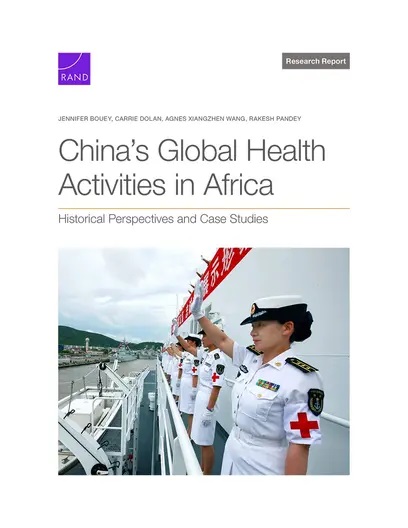China's Global Health Activities in Africa
Jennifer Bouey, Carrie Dolan, Agnes Xiangzhen Wang, Rakesh Pandey

In this report, the authors describe the evolution of the People's Republic of China's global health activities and related policies in Africa from the 1960s through the present and provide field case studies of two African nations — Sierra Leone and Kenya — that have received health aid from China. They then analyze China's use of global health support in Africa as a tool of soft power.
The need to understand China's global health activities has intensified, given that Western, particularly U.S., foreign health aid policies are changing, prompting questions about whether China will shift its policies to strengthen its soft power in Africa and away from the decade-old Belt and Road Initiative's overarching Sino-centric trade focus.
This analysis of China's health aid history, its current role in African health aid, and its recent reform called for by President Xi Jinping's Global Development Initiative is intended to help U.S. policymakers understand China's decisionmaking and implementation strategy for foreign aid. The analysis of the advantages and weaknesses of China's approaches can offer lessons to both donor countries and African countries that receive global health aid from China. The authors offer policy recommendations for the United States and for African countries.
Key Findings
-
China's health assistance has evolved through three distinct phases: In phase I (1949–1978), aid was driven by Maoist revolutionary ideology, promoting anti-imperialism solidarity. During phase II (1979–2021), motivations shifted to supporting China's economic development, often blurring the lines between aid and investment. In phase III (2021 to present), China's approach transitioned toward soft power in great-power competition.
-
Chinese health aid in Africa has increased dramatically in both quantity and variety over the past two decades, growing approximately fivefold from 2000 to 2019, and surged further during the coronavirus disease 2019 (COVID-19) pandemic. It began with China dispatching a clinical professional team to the recipient country to support local health care delivery and providing medical training in the 1960s and expanded to include multilayered health aid, such as anti-malaria projects, humanitarian aid during pandemics, regional public health surveillance labs, and multilateral collaborations.
-
African stakeholders have expressed mixed views of Chinese health aid. They acknowledge valuable infrastructure contributions: hospitals, medical equipment, mobile clinics, pandemic supplies, laboratories, and training programs that strengthen health systems. However, significant concerns persist, including language and cultural barriers, concerns about loan-based projects that increase the country's debt, lack of transparency and suspicions of corruption, lack of consideration of local needs, and sustainability questions.
-
China's experience reveals three pitfalls undermining health aid effectiveness: Subordinating aid to commercial interests eroded trust and soft power; opaque bilateral negotiations enabled corruption; and treating aid as an economic tool sidelined public health and caused chronic underinvestment in global health workforce development.
Recommendations
-
The United States should improve its understanding of China's global health activities in Africa, including both aid and investment elements. It should adopt an analytical approach to assessing China's health assistance programs, recognizing both their strengths and systematic limitations when mixing aid and investment, without exaggerating the competitive threat or underestimating their appeal to recipient countries.
-
The United States should maintain a focus on health and resist overcommercialization. A commerce-first approach not only compromises health outcomes but also creates the very economic-dependency relationships and trust deficits that effective health diplomacy should avoid.
-
The United States should preserve multidisciplinary global health workforce development. It should recognize the strategic value of its established multidisciplinary global health workforce as a critical comparative advantage that directly enables the America First Global Health Strategy's ambitious implementation goals.
-
African countries should leverage China's foreign aid reforms through regional and multilateral platforms. African countries should strategically capitalize on China's ongoing foreign aid reforms under the Global Development Initiative by strengthening regional coordination mechanisms and multilateral partnerships to enhance China health aid accountability and alignment with African priorities.
Sourced from https://www.rand.org/pubs/research_reports/RRA4151-1.html
RAND Corporation
